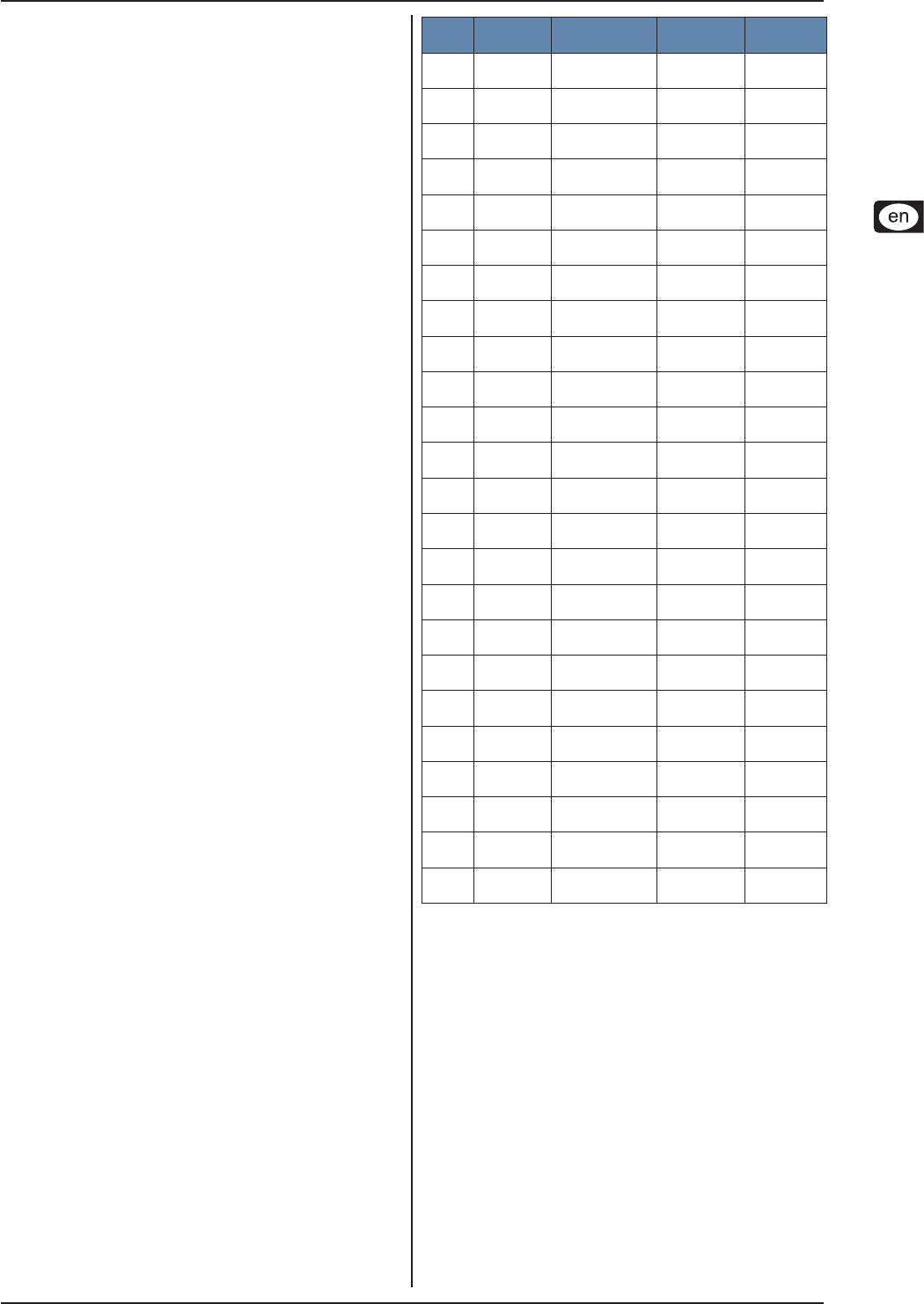
EURODESK SX4882
Live P.A. with 2-track recording 21
Choose to send to subgroups 7 and 8 from channels +
which are routed to tape from their DIRECT OUT.
Otherwise CHANNEL PAN, which will already have
been set for recording via another group, is unlikely
to be pointing to where you want the cue signal to go.
Aux sends 1 and 2 are available as two separate mono
headphone feeds, or as a single stereo headphone feed.
You’ll need an extra stereo amplier to amplify the aux
1 and 2 outputs to drive headphones properly.
Overdubbing:
It’s all change. Flip the recorded music onto A-channels, in order
to feed from tape into all the headphones buses.
Alternatively:
(and probably much more sensibly): use the headphones routine
outlined in section 15.2 (g. 15.1).
Wet monitoring16.3
It is customary with live recording to lay tracks dry. (Not so with
MIDI setups: often a tape track is used to record a complex effect.
In a MIDI studio a take is generally MIDI sequencer driven, and
hence reproducible should the recorded effected track eventually
prove to be unsuitable, in live recording, a great take is irreplace-
able! Hence the extra caution when laying live tracks.) With dry
recording you will probably want to audition tape tracks with
some reverb and/or echo, to get a better idea of how the nal
mix might sound. By pressing the AUX 3/4/5/6 SOURCE switch
(S17), aux buses 3 and 4 are available to the B-channels, i.e.
tape monitoring. You could send to reverb from input channels,
but the FX would disappear on tape playback. Bring the FX back
on aux returns 1, 2, 5 or 6. Remember 3 and 4 have been used
for headphones patching.
Mixdown16.4
All aux sends and subgroups are now available for mixing, as are
A-channels 23 and 24.
If you have two different instruments recorded onto one +
track, the mixdown settings for each might be totally dif-
ferent. Set up two A-channels. One for each instrument,
and switch between them.
The B-channels may be used e.g. as FX returns in place of the
normal aux returns (the advantage being that these channels have
PAN and EQ) or as an extra stereo aux send.
Live P.A. with 2-track recording17.
In this example we'll use the aux sends 1 and 2 for stage foldback,
and 3/4/5/6 for front-of-house effects. The P.A. is driven from the
main mix. MIX-B will be used to set up the mix to DAT.
Chan-
nels
Source FOH FX
Wedges /
monitoring
1 Kick
Subgroups 1
and 2 / MIX-B
-
Aux send 1
and 2
2 Snare
Subgroups 1
and 2 / MIX-B
Aux send 4
Aux send 1
and 2
3 Hi Hat
Subgroups 1
and 2 / MIX-B
-
Aux send 1
and 2
4 Tom 1
Subgroups 1
and 2 / MIX-B
Aux send 4 -
5 Tom 2
Subgroups 1
and 2 / MIX-B
Aux send 4 -
6 Tom 3
Subgroups 1
and 2 / MIX-B
Aux send 4 -
7 Tom 4
Subgroups 1
and 2 / MIX-B
Aux send 4 -
8
Cymbals
(overheads)
Subgroups 1
and 2 / MIX-B
- -
9
Keyboards
L
Subgroups 3
and 4 / MIX-B
-
Aux send 1
and 2
10
Keyboards
R
Subgroups 3
and 4 / MIX-B
-
Aux send 1
and 2
11 Bass DI
Main mix /
MIX-B
-
Aux send 1
and 2
12 Trumpet
Subgroups 5
and 6 / MIX-B
Aux send 5 Aux send 2
13 Trombone
Subgroups 5
and 6 / MIX-B
Aux send 5 Aux send 2
14 Sax
Subgroups 5
and 6 / MIX-B
Aux send 5 Aux send 2
15 BVs 1
Subgroups 7
and 8 / MIX-B
Aux send 5
and 6
Aux send 1
and 2
16 BVs 2
Subgroups 7
and 8 / MIX-B
Aux send 5
and 6
Aux send 1
and 2
17 BVs 3
Subgroups 7
and 8 / MIX-B
Aux send 5
and 6
Aux send 1
and 2
18 Conga L
Main mix /
MIX-B
- Aux send 2
19 Conga R
Main mix /
MIX-B
- Aux send 2
20
Guitar 1
microphone
Main mix /
MIX-B
-
Aux send 1
and 2
21
Guitar 2
microphone
Main mix /
MIX-B
-
Aux send 1
and 2
22 Lead vocal
Main mix /
MIX-B
Aux send 5
and 6
Aux send 1
and 2
23 FX 1 L
Main mix /
MIX-B
- -
24 FX 1 R
Main mix /
MIX-B
- -
Channel assignments 2-trackTab. 17.1:
Every B-channel has its own LEVEL, PAN and HIGH and LOW
EQ. MIX-B in fact is acting here like a totally independent separate
mixer, albeit with fewer facilities than the main mix. The primary ste-
reo reverb/echo unit's outputs have been patched into A-channels
rather than an aux return, to enable them to be sent to the MAIN
MIX and MIX-B independently.
S48 is UP, i.e. MIX-B is NOT blended into the main mix. +
Bringing the DAT back on aux 1 return P49 (as opposed +
to the 2-track or external inputs) enables not only audi-
tioning of DAT playback, but also balancing playback
level against the main mix, in case you also want to use
it to play a pre-recorded intro tape to set the scene for
the coming performance.
Be sure to have aux return 1 turned all the way down or +
de-assigned when recording to DAT. Otherwise expect
massive and terminal (as far as the P.A. and gig are
concerned) howlround.


















